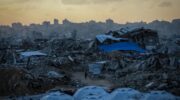From targeting humanitarian vehicles to standing by as mobs attack trucks, Israel is blocking aid from reaching Gaza.
by Prem Thakker, reposted from The Intercept, May 18 2024
On Monday, A mob of Israeli settlers attacked aid trucks carrying food supplies to Gaza. The extremists pillaged the cargo, destroying and smashing supplies desperately needed more than half a year into Israel’s assault on the besieged enclave. Israel’s police and military traded blame, each saying the other should have prevented it, but a senior security official told Haaretz that the rioters received “inside information about the trucks’ movement” from officers.
The incident is emblematic of a pattern that has played out repeatedly for months. Israelis, either vigilante extremists or state officials, block or outright attack humanitarian aid; the United States offers a milquetoast response or extends further favor to Israel; the violence continues and even ramps up. There is ample evidence of the Israeli government looking the other way as these attacks and obstructions on aid delivery play out. None of it is secret — much of it has been documented on camera and spread through social media.
Yet, the State Department, in a long-awaited report on whether Israel was complying with international humanitarian law as it used American weapons, concluded last week that Israel is not blocking aid. The State Department said that it had “deep concerns” about “action and inaction” by the Israeli government resulting in aid delivery to Gaza that “remains insufficient,” but concluded there was not enough evidence to justify cutting off assistance to Israel’s military.
Allison McManus, managing director of the national security and international policy department at the Center for American Progress, said the State Department’s findings are undercut by “the very obvious fact” of indiscriminate attacks on aid workers and civilians in Gaza.
“That is something that everybody can see with their own eyes. The killing of aid workers, the targeting of hospitals, the total destruction of the healthcare system, the massive number of civilian casualties, many of whom are women and children,” McManus said. “That does not happen in a context in which the prosecuting army is adhering to international law.”

Monday’s rampage was just one of multiple assaults on the aid sector in the days after the State Department issued its findings. That same day, Israeli forces attacked a clearly marked United Nations vehicle in Rafah — killing an Indian national staff member in the process. The targeting of the car raised fears around possible evacuation efforts for upward of 20 American doctors and medical workers stranded in Gaza. The killing did not deter President Joe Biden from moving Tuesday to send another $1 billion in weapons to Israel.
On Wednesday, in the occupied West Bank, settlers attacked a Palestinian truck driver because they thought he was driving an aid truck going to Gaza. Footage shows the victim writhing in pain as Israel Defense Forces officers roam the scene. Israeli police did not arrest any suspects, according to Haaretz.
The settlers deflated the tires of two trucks — which were running commercial routes rather than delivering aid — and set them on fire.
A video posted to Twitter by Alon-Lee Green, co-director of pro-peace organization Standing Together, showed people climbing onto a pillaged truck and dancing.
תראו את זה. תראו את חגיגת המוות וההשחתה והבזיזה. תראו באיזו שמחה הם חוגגים את ההרעבה. תראו את החיילים שעוברים שם, רגועים, ולא עושים דבר כדי לעצור את המתנחלים הפושעים האלה. תראו איך כולם שם בפנים חשופות, לא מפחדים שיעצרו אותם, פשוט כי ברור שהמשטרה לא תעצור אותם.
אתמול בגבעת אסף. pic.twitter.com/bwkmH8xi3L
— Alon-Lee Green – ألون-لي جرين – אלון-לי גרין 🟣 (@AlonLeeGreen) May 16, 2024
As Israeli troops looked on, several people took selfies and photos of their own as they climbed the pile of discarded aid bags, the video shows.
More than 250 aid workers have been killed in Gaza since Hamas’s attack on October 7. Human Rights Watch has identified at least eight instances of Israeli forces attacking aid convoys and premises. Some of these incidents took place despite aid groups providing their coordinates to the Israeli government to ensure their protection.
Among the incidents addressed in last week’s State Department report is Israel’s strike against a World Central Kitchen convoy that killed seven aid workers last month. The State Department said it could not reach “definitive conclusions” on whether U.S.-supplied weapons were used during that attack.
The State Department conceded such attacks “created an exceptionally difficult environment for distributing and delivering aid,” but did not describe such efforts as a systematic Israeli policy.
A recent report by U.K.-based research group Forensic Architecture has found at least 80 separate Israeli attacks on aid in Gaza since January alone. “The frequency and widespread nature of these attacks suggests that Israel is systematically targeting aid,” the group wrote.
In a statement to The Intercept, an IDF spokesperson said that the military takes “all operationally feasible measures to mitigate harm to civilians, including aid convoys and workers. The IDF has never, and will never, deliberately target aid convoys and workers.”
The spokesperson continued: “The IDF makes extensive efforts to enable the safe delivery of humanitarian aid, and has been working closely with various aid groups to coordinate and realize their vital efforts to provide food and humanitarian aid to the people of Gaza. Given the ongoing exchanges of fire, remaining in an active combat zone has inherent risks. The IDF will continue to counter threats while persisting to mitigate harm to civilians.”
Last week’s State Department assessment concluded that Israel “likely” violated laws using American-supplied weapons. Biden’s admission that American arms have killed Palestinian civilians calls into question a memo issued last year that says the U.S. would not authorize any arms transfer where there is risk of “facilitating or otherwise contributing to” human rights or international law violations.
Video after video has shown Israeli demonstrators blocking and even destroying aid meant for Gaza — sometimes in the presence of police or military authorities.
These demonstrations ramped up after the International Court of Justice found that the Israeli government is plausibly committing genocide and ordered it to facilitate aid distribution and prevent potential further acts of genocide. Protesters responded by attempting to block aid for days on end, with little pushback by Israeli authorities.
In one video dated February 9 at the Nitzana border crossing into Egypt, Israeli demonstrators block aid trucks from entering Gaza. “My friends, we closed the border crossing today,” one demonstrator exclaims as officers close the gates, prompting ululating from the crowd. “With all due respect my friends, the gate is closed,” the demonstrator continued through a megaphone, “someone is going to sleep hungry tonight.”
A group of demonstrators defended their action, telling the Times of Israel that “the hundreds of aid and supply trucks for the Hamas terrorist organization will not enter through here today.” The group added that they were “proud and moved.”
The state’s permissive attitude toward these demonstrations stands in stark contrast to its handling of Israelis looking to support the people of Gaza. Anti-government protests in Israel, some including families of victims held hostage by Hamas, have been met with fierce response. Standing Together, the pro-peace organization, has tried to deliver aid to Gaza; in one such attempt in March, the activists were stopped by police.
A week later, Israelis trying to block aid are seen in a video report fraternizing with the authorities; one tells a journalist: “Kill them, I don’t care.”
Another protester says police gave them lollipops and watermelon while watching them prevent aid from crossing the border: “The policeman, the head commander, came to us and said ‘OK, you guys came and blocked, we don’t want to fight.’ And he said to us ‘I’ll just lock the gate. You guys don’t need to stand in the sun.’”
Efforts to block aid deliveries in full sight of Israeli authorities have continued this month.
An early May video posted to Twitter by Middle East Eye shows demonstrators dancing and chanting in a large circle, blocking scores of trucks destined for Gaza.
Israeli settlers damaged humanitarian aid trucks, including slashing their tyres and destroying boxes of food, as they were bound for Gaza at the Beit Hanoun (Erez) crossing. pic.twitter.com/kDjKbvNq7j
— Middle East Eye (@MiddleEastEye) May 8, 2024
As the video pans the crowd of people triumphantly singing and waving flags, officers don’t intervene.
In its report last week, the State Department narrowly identified the demonstrations blocking aid crossings in January and February as also creating a “difficult environment” for aid delivery.
In Jerusalem, a mob set fire to the headquarters of the United Nations Relief and Works Agency for Palestinian Refugees in the Near East last week.
Juliette Touma, UNRWA’s communications director, said that the attack was not spontaneous. There were numerous attempts to set fire to the premises, she said, predated by weeks of harassment by extremists. Mobs have come to the gates of the compound to intimidate and bully UNRWA staff, throw stones, and even threaten them with guns, she added.
Jerusalem Deputy Mayor Aryeh King has himself joined in the attacks. Upon UNRWA temporarily closing operations at the headquarters last week, King said it was “an honor to be responsible” for it.
Along with the scores of attacks, basic aid facilitation itself has been substandard. Touma noted that before October 7, Gaza was reliant on 500 aid trucks per day due to Israel’s 16-year blockade. For the first two weeks after the assault, she added, Gaza was under a “hermetic siege,” with days’ worth of aid never coming in. Even when aid deliveries resumed, the pace has substantially slowed. Based on data from Coordination of Government Activities in the Territories, a branch of the IDF, only 127 trucks have entered Gaza per day as of May 15.
That’s in part because of the structural barriers the government has placed upon aid. The Israel government has barred UNRWA from delivering aid to the northern part of Gaza — an area facing additional displacement notices this week as it again comes under Israeli attacks
Aid delivery has long been hindered at the Rafah border crossing with Egypt, in the southernmost part of Gaza. At one point in January, hundreds of trucks carrying aid stood in line for weeks, waiting for permission to enter Gaza.
Upon visiting for themselves, Democratic Sens. Chris Van Hollen and Jeff Merkley blamed it on a cumbersome process that included arbitrary rejections of vital humanitarian equipment. In May, Israel took over and closed the border crossing as it began a ground invasion into Rafah, where 1.4 million displaced Palestinians take refuge.
Prem Thakker is a politics reporter for The Intercept. His interests include climate and the environment, corporate and political corruption, civil rights and justice, and labor.
RELATED ARTICLES:
- Not even the US government knows the US government line on Rafah
- Blinken Says Israeli Units Accused of Serious Violations Have Done Enough to Avoid Sanctions. Experts and Insiders Disagree.
- Manipulation Politics: Israeli Gaslighting in the United States
- A history of how Israel out-foxed US Presidents, from Eisenhower to Obama
- Watch: Congressman Gus Savage exposes the Israel Lobby’s illicit tactics
- Fortas, Breyer, Brandeis, Frankfurter, Ginsburg: Israel partisans
- Study: At least 78% of humanitarian aid intended for Palestinians ends up in Israeli coffers
- Israeli communities near Gaza are on stolen land, former owners consigned to the Gaza ghetto
- Old Palestinian photos & films hidden in IDF archive show different history than Israeli claims





